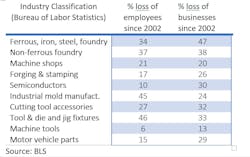Are We Ready for Reindustrialization?
Russia’s invasion of Ukraine and Chinese President Xi Jinping telling the Communist Party Congress that he is prepared to invade Taiwan reveals the true incompatibility of our economic systems. Meanwhile, U.S. multinational corporations have awakened to how vulnerable they are because of China’s willingness to weaponize and politicize supply chains.
We now have critical shortages in a wide range of industries and technologies. I think it is time for the United States to get on a “wartime footing” and begin to accelerate reshoring, rebuild American industries and put reindustrialization into overdrive.
America has awakened to critical shortages
Decades of outsourcing have created shortages in a wide range of industries that make the U.S. vulnerable to rogue countries like China. Here are some examples:
1. Information, communication and telecommunication products (ICT). The U.S. has allowed critical information, communication, and telecommunication technologies to be outsourced to foreign countries. The U.S. now imports $248 billion of these technology products.
2. Flexible manufacturing. This is about labor-saving devices in all kinds of automation, including robotics. In 2017, China installed 138,000 robots in plants in China, while the U.S. installed 34,000. The International Federation of Robotics (IFR) shows 310,700 industrial robots operating in factories in the United States in 2021, and almost none of these robots were manufactured in the U.S.
3. Rare-earth minerals. Rare-earth elements are a group of 17 minerals used in cell phones, magnets, wind turbines, batteries, electric vehicles and military weapons systems. Eighty-five percent of rare earth elements now come from China, which gives them the ability to control supply and paralyze our technology and defense sectors.
4. Semiconductors. Even though semiconductors were invented in the United States, after decades of outsourcing, today only 12% of semiconductors are manufactured in the U.S. New semiconductor factories are being built in Ohio and Arizona, but this requires $52 billion in government subsidies from the CHIPS Act. Despite these subsidies, the CHIPs Act cannot stop U.S. companies from manufacturing in China, so preventing future shortages will depend on the companies’ commitment to reshoring.
5. Automobile parts. Table A shows that we have lost 821 establishments and 186,985 employees since 2002. The U.S. imported $74 billion of auto parts in 2021. China is among the world’s largest suppliers of car parts, exporting motor vehicle parts and accessories worth $34.8 billion in 2018.
6. Pharmaceuticals. In June 2022, the FDA published a list of 36 drugs in short supply, and 21 were considered critical medicines. In addition, 65% of all" active pharmaceutical ingredients" (API) come from either China or India. The United States is dependent on imports for two thirds of generic medicines, which are 90% of all prescriptions. America is dangerously dependent on drugs from India and China and any restrictions of their shipments would be a disaster for hospitals and clinics.
7. Electric vehicle batteries. The U.S. is lagging behind China and the European Union in the production of lithium-ion batteries for electric vehicles because of limited access to the critical materials used in battery components. There are some significant investments in new battery plants because of the Inflation Reduction Act, but if the U.S. wants to control its supply chain, the government is going to have develop domestic sources of rare earth materials and lithium.
8. Critical metals. The Department of Interior identified 35 critical minerals crucial for national security. These include the import of lithium, titanium, nickel, cobalt and manganese. General John Adams says the U.S. is reliant on imports for nearly 50 minerals and metals and 100% reliant for 18 of them.
These kinds of shortages have led many politicians and corporations to take a hard look at America’s vulnerabilities and face the fact that the U.S. is now at the mercy of rogue nations like China. The Coalition for a Prosperous America’s Domestic Market Share Index (DMSI) also shows that domestic producers’ share of their home market fell to a record low of 63.8 % in Q2 of 2022. If the U.S. is to be less vulnerable to shortages, trade disruptions, natural disasters, war and blackmail, we must develop a strategy to accelerate reshoring production and jobs.
Good News
Globalization and the decades-long multinational corporation rush towards finding the lowest price anywhere may be weakening. Larry Fink, of Black Rock Financial, said in his 2022 letter to shareholders that "supply chain disruption caused by the pandemic and Russian invasions of Ukraine has put an end to globalization we have experienced over the last three decades.”
Another finance guy, Howard Marks, co-chairman of Oaktree Capital Management, said," the negative aspects of globalization have now caused the pendulum to swing back towards local sourcing.” Outsourcing, he says, "led to the elimination of millions of jobs and the hollowing out of manufacturing regions and the middle class of our country.”
So, the question is, why would the financial firms who have been big investors in globalization change their minds? Perhaps one explanation for why globalization is waning might be explained in the new book “Homecoming,” by Rana Foroohar, a New York, financial analyst. She makes the case that employers, small cities and suppliers were left stranded by globalization, causing political changes and forcing many American corporations to rethink their investments in foreign countries.
She is right about political changes. There is now a bill in Congress called the National Critical Capabilities Defense Act (NCCDA) that would require companies to disclose proposed offshoring to foreign adversaries of critical supply chains and capabilities.
The Industrial Commons
Besides losing our technology and inventions to our competitors, we have lost the skilled workers, the know-how, the suppliers and the capital investment that come with investing into production at scale. This is called the “industrial commons” by Gary Pisano and Willy Shih in their book “Producing Prosperity.” They make the argument that “investing in the industrial commons is not a matter of patriotism; it’s a matter of good business leadership—and when a country loses its capability to manufacture, it loses the ability to innovate”.
Reshoring the industrial commons is going to take an investment in basic industries that are ubiquitous to manufacturing processes. The table below shows that these 10 critical industries continue to lose establishments and employees. We are going to have to reshore and rebuild these industries and our industrial commons if we are to have a chance at reducing shortages and reshoring production. (You can see a more detailed table, with numbers on employees and establishments lost, in my new book.)
The other part of the industrial commons is the skilled workers needed in reshoring, which I have written about many times in the last decade. We need highly skilled workers in these 10 critical industries: machinists, tool and die and mold makers, foundry workers, maintenance technicians. These professions require specialized apprenticeships. But so far, most of the multinationals have not been willing to fund advanced training that takes thousands of hours to complete. Perhaps a tsunami of reshoring might change their minds—or maybe they are waiting for the government to fund apprentice training.
After decades of outsourcing, the U.S. has a golden opportunity to reshore industries, technologies and jobs. The following measures would accelerate reshoring and help to reindustrialize America:
- Implement a market access charge on incoming capital flows that finance the deficit to decrease the value of the dollar and help make exports viable
- Repeal the Permanent Normalized Trade status of China if they invade Taiwan, and begin the process of decoupling
- Extend the current Section 301 tariffs to include Chinese products listed in section 4A and 4B
- Pressure the Treasury Department to invoke a new version of Reagan’s 1985 Plaza Accords to stop our competitors from manipulating their currencies
Michael Collins is the author of a new book, “Dismantling the American Dream, How Multinational Corporations Undermine American Prosperity.” He can be reached at mpcmgt.net.

